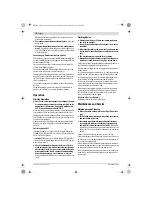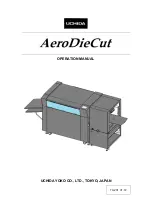
18
| English
2 610 017 516 | (3.11.11)
Bosch Power Tools
Observe the relevant regulations in your country for the
materials to be worked.
f
Prevent dust accumulation at the workplace.
Dusts can
easily ignite.
f
When working without dust extraction, always mount
plug 2.
Fragments of the workpiece or of a broken acces-
sory may fly away and cause injury beyond the immediate
area of operation.
Connecting the Dust Extraction (see figure G)
Pull plug
2
out of vacuum connection
20
. Mount elbow
19
and
vacuum hose
18
(accessories) together. Insert elbow
19
into
vacuum connection
20
.
Swing out the holder
6
for the vacuum hose and clamp the
vacuum hose
18
in the holder.
Connect vacuum hose
18
via adapter
21
(accessory) to the
vacuum hose of a vacuum cleaner (accessory).
The machine can be plugged directly into the receptacle of a
Bosch all-purpose vacuum cleaner with remote starting con-
trol. The vacuum cleaner starts automatically when the ma-
chine is switched on.
The vacuum cleaner must be suitable for the material being
worked.
When vacuuming dry dust that is especially detrimental to
health or carcinogenic, use a special vacuum cleaner.
Operation
Starting Operation
f
Observe correct mains voltage! The voltage of the pow-
er source must agree with the voltage specified on the
nameplate of the machine. Power tools marked with
230 V can also be operated with 220 V.
When operating the machine with power from mobile genera-
tors that do not have sufficient reserve capacity or are not
equipped with suitable voltage control with starting current
amplification, loss of performance or untypical behavior can
occur upon switching on.
Please observe the suitability of the power generator being
used, particularly with regard to the mains voltage and fre-
quency.
Switching On and Off
To
start
the power tool, push the On/Off switch
1
forwards.
To
lock
the On/Off switch
1
, press the On/Off switch
1
down
at the front until it latches.
To
switch off
the power tool, release the On/Off switch
1
or,
if it is locked, briefly push down the back of the On/Off switch
1
and then release it.
f
Check the diamond cutting discs before use. The dia-
mond cutting disc(s) must be mounted properly and be
able to rotate freely. Carry out a test run for at least one
minute without any load. Do not use diamond cutting
discs that are damaged, out-of-balance, or vibrate.
Damaged diamond cutting discs can rupture and lead to in-
juries.
Working Advice
f
Clamp the workpiece if it does not remain stationary
due to its own weight.
f
Do not strain the machine so heavily that it comes to a
standstill.
f
After heavily straining the power tool, continue to run
it at no-load for several minutes to cool down the acces-
sory.
f
The machine may only be used for dry cutting.
f
Diamond cutting discs become very hot during opera-
tion; do not touch them until they have cooled down.
Protect the cutting disc against impact, shock and grease. Do
not subject the cutting disc to lateral pressure.
Do not brake coasting diamond cutting discs by applying side-
ward pressure.
For cutting expecially hard material, e. g., concrete with high
pebble content, the diamond cutting disc can overheat and
become damaged as a result. This is clearly indicated by cir-
cular sparking, rotating with the diamond cutting disc.
In this case, interrupt the cutting process and allow the dia-
mond cutting disc to cool by running the machine for a short
time at maximum speed with no load.
Noticeable decreasing work progress and circular sparking
are indications of a diamond cutting disc that has become
dull. Briefly cutting into abrasive material (e. g. lime-sand
brick) can resharpen the disc again.
Direction of Cut (see figure H)
Guide the machine as shown in the figure.
Maintenance and Service
Maintenance and Cleaning
f
Before any work on the machine itself, pull the mains
plug.
f
For safe and proper working, always keep the machine
and ventilation slots clean.
f
In extreme conditions, always use dust extraction as
far as possible. Blow out ventilation slots frequently
and install a residual current device (RCD).
When work-
ing metals, conductive dust can settle in the interior of the
power tool. The total insulation of the power tool can be im-
paired.
Please store and handle the accessory(-ies) carefully.
If the replacement of the supply cord is necessary, this has to
be done by Bosch or an authorized Bosch service agent in or-
der to avoid a safety hazard.
If the machine should fail despite the care taken in manufac-
turing and testing procedures, repair should be carried out by
an after-sales service centre for Bosch power tools.
In all correspondence and spare parts order, please always in-
clude the 10-digit article number given on the type plate of
the machine.
OBJ_BUCH-1502-001.book Page 18 Thursday, November 3, 2011 3:02 PM
















































